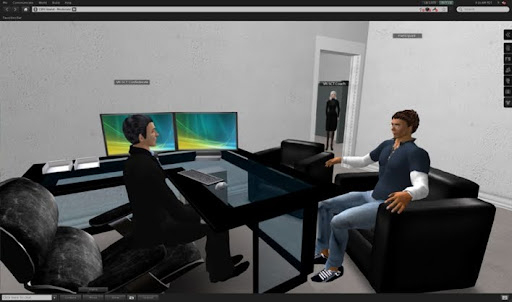
I tried on a virtual reality (VR) headset for the first time about a month ago. Though the fit was awkward at first, and it gave me a headache after about thirty minutes, I came out of the experience shocked at how immersive it was. Even despite how awe-struck I was at the end of my session, I still felt like the technology was only just in its infancy. As Mel Slater and Maria Sanchez-Vives put it, “VR is revolutionary, even though it has taken 50 years to get from the initial idea in the lab to becoming a mass consumer product. How this product might develop and change the world in which we live remains unknown”[1]. Because of how new VR technology is, we can only just begin to predict the potential impact it could have. One of the most important potential use cases for VR is improving equity in regard to neurodivergent people; both by offering more immersive therapies to help them better acclimate to different aspects of society, or by improving empathy training in order to facilitate more societal tolerance towards neurodivergence.
VR is particularly useful for helping people with disorders that affect social skills such as autism. Autism is a condition that often results in the person affected having a harder time in certain social situations. People with autism can experience difficulty with conveying their thoughts, communicating nonverbally, interpreting social cues, understanding the emotions of others, and adapting speech to fit different social contexts [2]. Because of these difficulties, those with autism can sometimes struggle to make and maintain friendships, which can worsen their quality of life. However, there are many ways to assist those with autism in navigating social situations, some of which are more effective when done in a VR environment. In a research study, individuals diagnosed with an autism spectrum disorder were tested on a variety of different social skills before and after practicing social skills in a VR environment. These social skills include recognizing emotions both verbally and nonverbally as well as conversational skills. The data from the study showed that those who underwent the VR training experienced significant improvements when tested for each of the mentioned social skills [3]. Virtual reality provides a more efficient manner to help people with autism improve their social skills, which has the potential to significantly improve their quality of life.
Not only is VR useful in helping autistic people improve their social skills, it can also help those suffering from Post Traumatic Stress Disorder (PTSD) manage and reduce their symptoms over time. PTSD occurs after a person experiences a traumatic event. The symptoms usually begin within 3 months of the initial event, and include four general categories of symptoms: re-experiencing, avoidance, reactivity, and mood. Traditionally, it is treated using talk therapy, exposure therapy, and medication [4]. Exposure therapy, while it may be effective, can be costly for those involved since the environment is difficult to control. Thus, doing exposure therapy through virtual reality would be cheaper than traditional exposure therapy, making it more accessible to those who need it most. In addition, a meta-analysis of 7 studies has shown that exposure therapy that utilizes VR has the potential to be more effective than traditional exposure therapy at treating PTSD. This is both due to it incorporating more immersive stimuli than traditional exposure therapy, as well as allowing for easier monitoring of the stress responses of the patient.[5]. Thus, incorporating virtual reality technologies into post traumatic stress disorder treatment will serve to both make it significantly more accessible and more effective than our current exposure therapy methods.
Though different therapies can significantly improve the quality of life of neurodivergent people, much of the difficulty that comes with being neurodivergent comes from the intolerance of other people. The only thing that can realistically be done to counter this issue is to have employers offer empathy training programs. Many companies and organizations already offer basic training programs for their employees in order to make them more understanding of the various circumstances their coworkers may be going through. These can include experiences such as facing discrimination or dealing with homelessness. Since many of these programs involve the client putting themselves in someone else’s shoes in order to empathize with them, VR has the potential to make the experience more effective, since it allows the client to feel more immersed in the life of the other person. One study that delves into this idea compares the difference in efficacy between a VR and a traditional version of an empathy course surrounding being homeless. In the traditional empathy course, participants read a brief story about a person who was evicted due to being unable to pay their rent, enabling them to experience what life is like for someone without a home. The VR version covers the same story, except the participant engages with it in virtual reality instead of just as a text. The study found that immediately after the program, the VR based course caused participants to report increased amounts of empathy and personal distress. It also found that over time, the VR based course led to increased attitudes towards the homeless over the long term, in addition to causing more participants to sign a petition in favor of increasing affordable housing options than the traditional course [6]. VR based empathy training courses will likely be significantly more effective than the current options offered to employers. This could serve to facilitate more equal interactions between neurotypical and neurodivergent people, which would improve the overall happiness of both parties.
Though VR technologies have the potential to make our society significantly more equitable, if proper measures are not taken then they could serve as yet another barrier dividing the upper and lower classes. VR as it is is expensive, with headsets costing anywhere from 300 to 3000 dollars. If infrastructure is set up so that it is difficult to access services such as education and employment without access to VR, they would end up only serving to price out those who are most in need of the benefits they can offer. This is not an inevitability, as there are many solutions that could be taken in order to prevent this. VR headsets could be distributed to families that fall below a certain income threshold, or they could be loaned out in public spaces in a similar fashion to how computers and internet access are made available for free at places such as libraries and schools. If steps such as these are taken, then it would aid in ensuring that VR serves as a force for equitable change, rather than one that creates more division in our society.


